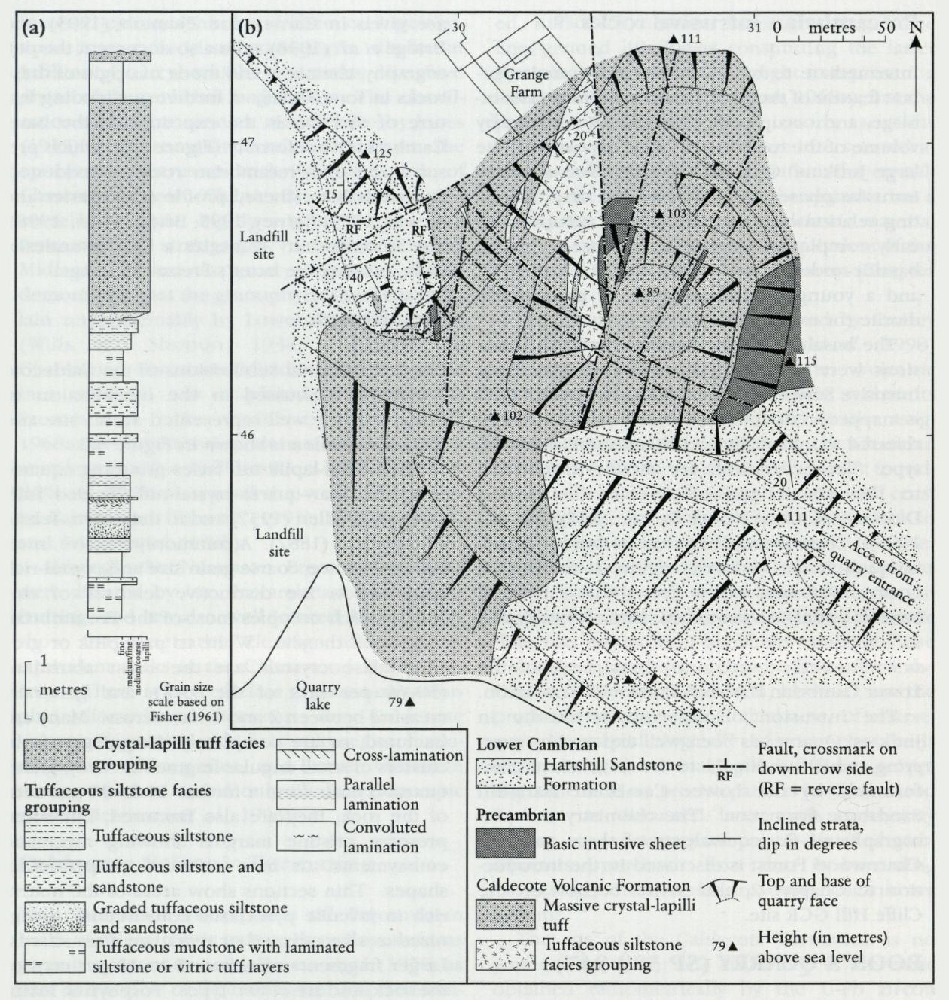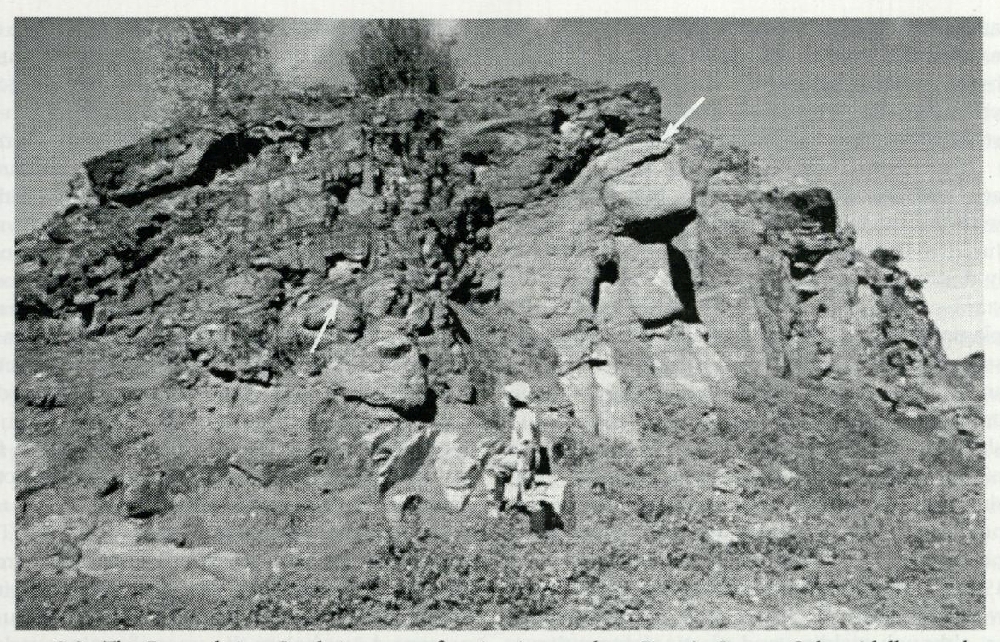Boon's Quarry
[SP 329 947]
J.N. Carney
Introduction
The highly accessible exposures of Precambrian and Cambrian rocks make the Boon's Quarry GCR site (Figure 3.2) one of the classic sites of British stratigraphy. In recognition of its importance, the quarry face immediately below (to the south of) Grange Farm has been designated the type section for the diverse volcaniclastic sequence constituting the Caldecote Volcanic Formation (Bridge et al., 1998). Many photographical illustrations of the various lithologies are given in Carney and Pharaoh (1993) and Bridge et al (1998), who also document the petrography, chemistry and mode of origin of these rocks in some detail. A further outstanding feature of this site is the exposure of the base-Cambrian unconformity (Figure 3.3), which preserves on the Precambrian rocks, a reddened, spheroidally-weathered profile (e.g. Brasier and Hewitt, 1979; Carney, 1995; Bridge et al., 1998). The unconformity truncates a basaltic-andesite dyke, proving the latter's Precambrian age.
Description
The two informal subdivisions of the Caldecote Formation, discussed in the introduction to Chapter 3, are well represented at this site and their distribution is shown in (Figure 3.2).
The crystal-lapilli tuff facies grouping equates to the feldspar–quartz–crystal-tuff (Welded Tuff) category of Allen (1957) and to the quartz–felsite of Lapworth (1882). A commonly massive internal appearance, coarse grain size and crystal-rich composition are distinctive features of this facies, which occupies most of the Precambrian outcrop at the site. White to pale pink or grey plagioclase crystals are the most abundant (50–60 per cent of the rock), and generally measure between 2 and 6 mm across. Many are fractured, or are completely disaggregated to clusters of small angular fragments. Grey, glassy quartz crystals form a further 15 to 20 per cent of the rock; they are also fractured, but some preserve pristine margins showing magmatic embayments, or have euhedral, bipyramidal shapes. Thin sections show areas of the matrix rich in juvenile pyroclastic constituents, recognized as sliver-shaped or reticulate glass shards. Larger fragments constitute 5 to 10 per cent of the rock, and are of two types. Porphyritic inclusions up to several centimetres in size were noted by Waller (1886) and Allen (1957). They have ovoid, discoid or equidimensional shapes, and commonly have ragged, sharply angular margins with the enclosing crystal-lapilli tuff. Their fine-grained matrix encloses plagioclase and quartz crystals of a similar size and composition to those in the host rock, although not as abundant. Lithic blocks commonly have sharp, angular margins against the host tuff; they include fine-grained aphyric to sparsely porphyritic andesite or dacite, devitrified glass with relict perlitic texture and welded tuff with fluidal textures.
The tuffaceous siltstone facies grouping is at least 5.5 m thick at the type section (Figure 3.2). It has a characteristic parallel stratification picked out by pale grey, dark grey and olive-green weathering tints, and is made up of regular alternations that define a series of upwards-coarsening cycles, the stratigraphically highest culminating in about 4 m of crystal-lapilli tuff. The mudstone component appears massive or only faintly laminated, but in polished slabs it commonly shows an intensely convoluted silty lamination. In thin sections the more silty laminae contain abundant sliver-shaped microcrystalline aggregates representing devitrified glass shards. Tuffaceous siltstone beds have a millimetre-scale parallel lamination, which is in places deformed into domical structures. Low-angle planar cross-lamination is more rarely seen, in one case giving a current flow almost due south. In thin sections the siltstone laminae are either crystal-enriched or composed of vitric tuff crammed with Y-shaped devitrified glass shards up to 1 mm in size. Tuffaceous sandstone beds are 5 to 20 mm thick; their bases are sharp and in places show erosion or are loaded into underlying mudstone. Normal grading is very common, and results in repetitively graded sequences, of sandstone passing up to siltstone and mudstone, representative of the 'Bouma' b-e turbidite divisions (Bouma, 1962).
The basaltic-andesite sheet truncated by the unconformity at Boon's Quarry is 3 m thick and composed of a fine-grained, dark green-grey rock. Its top becomes reddened within a few metres of the base of the Precambrian–Cambrian unconformity.
In keeping with the Precambrian sequences of the Nuneaton inlier, the rocks at Boon's Quarry show no evidence for penetrative cleavage deformation. There are, however, coarse sub-vertical joint sets, with a 1 m spacing, developed in the eastern wall of the small pit at the type section.
Interpretation
The Caldecote Volcanic Formation is, in terms of its grain size, a markedly diverse lithological association, although beds of the crystal-lapilli tuff facies are dominant. These lithologies are extremely coarse-grained and of 'proximal' aspect, but they were evidently deposited within a basin that was accumulating finer-grained and more distal sediments, represented by the tuffaceous siltstone facies grouping. Deposition of all of these strata in standing water is suggested by the presence of graded bedding, domical lamination indicative of liquefaction and possibly water-escape, convolute lamination and cross-lamination in the tuffaceous siltstone grouping. Moderate to deep-water conditions that were well below wave-base are further indicated by the absence of wave or tidal current-generated sedimentary structures. In keeping with this type of environment are features such as repetitive normal grading, interpreted to indicate deposition from distal, high-density turbidity currents (Lowe, 1982). The upwards-coarsening sedimentary cycles may have formed at times of progressively increasing seismic and/or eruptive activity, when rapidly accumulated material sloughed off the flanks of the volcanic axis. Glass shards that are locally concentrated in siltstone laminae testify to contemporary pyroclastic activity in the source region(s) of the volcanic arc (see 'Introduction', this chapter). Such beds are the deposits of ash falls into water, followed by reworking by bottom currents to form the characteristic laminated and cross-laminated structures.
Rocks of the crystal-lapilli tuff facies grouping are both conformable and intimately layered with the tuffaceous siltstone beds at the nearby Judkins' Quarry site, and therefore were similarly deposited under water. Their relatively constant crystal proportions, of about 55 per cent plagioclase and 20 per cent quartz, indicates a strong source control over their composition and suggests that most beds are compositionally immature. This is also indicated by the lack of abrasion of the crystals and delicate preservation of juvenile pyroclastic material, seen as glass shards in the matrix. These tuffs are possibly the products of pyroclastic eruptions derived from phenocryst-rich dacitic magmas (Bridge et al., 1998). Previous workers suggested that they were welded tuffs (Allen, 1957, 1968a); however, although welding and plastic deformation is seen in some of the included blocks, true matrix shards are generally little-deformed and mainly show random orientation, arguing against welding on a significant scale after deposition. They are probably not welded tuffs as considered by Wright et al. (1980), but more resemble a category of subaqueous pyroclastic flow that has been described in basins marginal to volcanic arcs (Fiske and Matsuda, 1964). Such flows are viewed as having originated either from submarine eruptions, or from subaerial pyroclastic flows that subsequently entered water (see discussions in Fisher, 1984, and Stix, 1991). Crystal enrichment processes can operate in conjunction with this type of activity (Cas and Wright, 1987), but the large size of the crystals also indicates that the parental material was initially highly porphyritic.
Later in the arc's evolution the magmas became more basic and were introduced as basaltic-andesite sheets. These are the chemical equivalents of the North Charnwood Diorites (Carney and Pharaoh, 1993; Bridge et al., 1998), and like the rest of the Caldecote Formation they were emplaced within a relatively juvenile arc.
Conclusions
Boon's Quarry occupies a small area but its accessibility, and the representative nature of the lithologies that are exposed, justify its selection both as a GCR site and the type section for the Caldecote Volcanic Formation. Sedimentary structures in the tuffaceous siltstone facies grouping indicate subaqueous deposition at moderate depths (at least) by a combination of turbidity current activity and the direct fall-out of fine ash. This fine-grained sedimentation either took place at some distance from the active volcanoes, or reflects times of relative quiescence. The crystal-lapilli tuff facies grouping, in contrast, is extremely coarse-grained and its remarkable uniformity of appearance, combined with its abundance of juvenile pyroclastic material (euhedral and shattered crystals, glass shards), suggests that it may have been generated by highly explosive, large-volume eruptions followed by subaqueous flowage of the ejected material. Basaltic dykes were then intruded as a prelude to magmatic cessation. The Precambrian rocks were later uplifted and eroded, and the remnant of a former spheroidal weathering profile on these rocks is uniquely preserved just below the unconformity overlain by Lower Cambrian strata.
References


